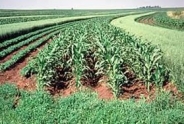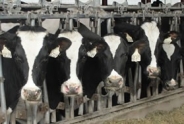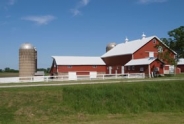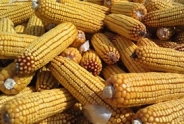Don't Leave Alfalfa Leaves in the Dust
By Mike Rankin: Hay and Forage Grower
Fall is always a good time to focus on leaves. In fact, people drive hundreds of miles to states such as Vermont to view the collage of leaf colors, while for many of us, autumn brings an unwelcomed leaf-raking ritual.
With so much attention on leaves, this might also be a good time of year to view and evaluate your harvested alfalfa to assess how much leaf retention actually occurred over the summer, or if too many leaves are being left in the dust by the baler or chopper.
Most alfalfa producers know that leaves are important to retain in the bale or silo. In fact, for high-quality alfalfa, it's not just important to retain leaves — it's critical!
Just how critical?
Consider that a University of Wisconsin study showed that leaf percentage accounts for 70% of the variation in harvested alfalfa quality. In some recent work done by David Weakley with Forage Genetics International (FGI), he found that relative forage quality (RFQ) rose by 4.6 units for each 1 unit change in leaf percentage. In other words, a 5-unit bump in leaf percentage boosts RFQ by 23 points.
It's not surprising that leaf percentage has a huge impact on forage quality when one considers that leaves have a neutral detergent fiber (NDF) value of 15% to 20% and an RFQ of about 500. On the other hand, stems have an NDF value of 60% to 70% and an RFQ of only 50 to 120, depending on maturity stage. Leaves also have a crude protein content that is two to four times higher than stems.
Dan Undersander, emeritus professor and former forage specialist with the University of Wisconsin, has often said that alfalfa leaf retention has more impact on forage quality than plant maturity. Leaves don't change much in quality with maturity while stem quality declines rapidly. That said, leaf loss from foliar diseases can be an issue as plants mature.
Although we first think of forage quality loss because of lost leaves, yield may also take a significant hit.
Most estimates put an average bud-stage alfalfa stand at about 50% leaves, although the range is often cited at 40% to 60% because variety, growing environment, and plant maturity impact the ratio of leaves to stems.
Where do losses occur?
Sometimes significant leaf losses take place before harvest as a result of foliar plant disease. This is especially the case in humid regions and can only be limited by variety selection, foliar fungicides, and/or a timely harvest. The degree that is a recurring problem is easily checked by looking underneath the alfalfa canopy to see how many leaves are lying on the ground.
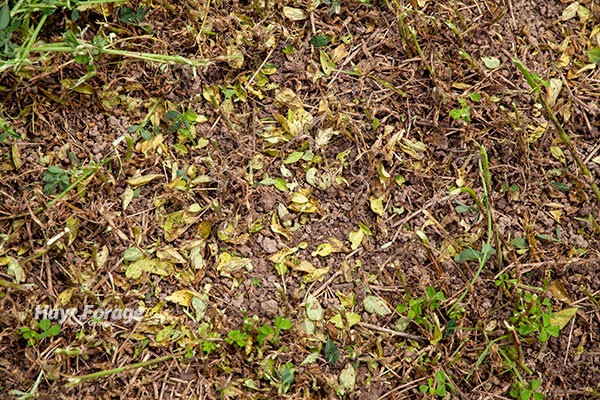 Foliar diseases can contribute to significant leaf drop prior to harvest, especially in the first cutting.
Foliar diseases can contribute to significant leaf drop prior to harvest, especially in the first cutting.Limited leaf loss should occur when cutting and conditioning the crop unless a flail conditioner is being used. Flail conditioners are designed for use on grass crops where leaf loss is a nonfactor.
From cutting to baling or chopping is generally where there is the most opportunity for leaf loss. Swath or windrow manipulation is often a necessary evil, but if it's done when the forage is much drier than 30% moisture, leaf loss is nearly unavoidable, especially with a rotary, basket, or wheel rake. This is why most producers manipulate the alfalfa early in the morning when external dew can work to the haymaker's advantage.
Leaf loss at the baler or chopper can also be significant. Chopping hay that is too dry is especially a leaf-loss killer as dry leaf particles are offered to the wind before ever reaching the truck or wagon.
Where do you stand?
In the past year, an alfalfa leaf percentage test called LEAF has been developed and made available at most of the major forage testing labs. Although this test isn't something that producers would likely request for all of the hay or haylage they make or sample, it might be a test to help aid in assessing a farm's overall ability to preserve leaves.
As a general guideline, alfalfa leaf percentage should be above 40% and preferably above 45%. Any result below 40% is worthy of questioning where leaf loss is occurring. It might also be enlightening to test alfalfa at various points from cutting to baling or chopping.
Alfalfa leaves hold the key to its feeding benefits. Guard and maintain them from preharvest to storage.
Upcoming Events
Memoir Reading: Barn Gothic
December 4, 2025
Bath, NY
Barn Gothic is an elegy for family farmers and an intimate portrait of three generations laboring to be fathers and sons while their livelihood falls apart. Beautifully told with a farmer's restraint and a poet's grace, it is a story of personal loss amid corporate corruption and of finding a way forward when everything you know disappears.
NY Small Farms Summit 2025: Stronger Together
December 5, 2025
Alfred, NY
We hope you will join us on December 5th for the 2025 New York Small Farms Summit! This is an opportunity to meet other farmers and ag supporters, learn about research and education projects, and set priorities for future efforts to grow small farm success.
At the Allegany County site, we will focus on giving trees a chance and how trees build resiliency on small farms. Whether attracted to fruit, nuts, vegetables, fodder or shade, trees can be an integral part of a successful farming system. Join us as we explore the opportunities for resiliency that come from adding tree crops or managing wooded areas of your farm for agroforestry or silvopasture systems.
Crops, Cows & Critters - Southwest New York Dairy, Livestock & Field Crops Newsletter Sponsorship
December 19, 2025
Our two forms of publications feature research-based and timely information from our four specialists, listed to the right, along with local event notifications and Cornell University outreach. This information is provided to participants who range from dairy, livestock, and field crops producers to agricultural suppliers and consultants.
Weekly Email Update: Shared with 625+ households who have signed up with our program.
Monthly Paper Mailer: To reach our stakeholders and farmers who lack internet access, we send out a monthly mailer where your company's logo and contact information would be featured with a mailing list of 330+ households.
If you sponsor our weekly and monthly publications you reach approximately 955 households.
Visit our website to view our newsletters!
Announcements
No announcements at this time.

